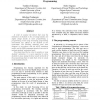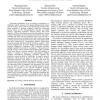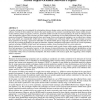61 search results - page 5 / 13 » The complexity of learning according to two models of a drif... |
HICSS
2003
IEEE
14 years 20 days ago
2003
IEEE
Basically, instrumental conditioning is learning through consequences: Behavior that produces positive results (high “instrumental response”) is reinforced, and that which pro...
ICALT
2007
IEEE
13 years 9 months ago
2007
IEEE
In order to analyze the factors that raise the motivation of students in the art design faculty and digital design faculty to learn programming, a programming course using Process...
CCECE
2006
IEEE
14 years 1 months ago
2006
IEEE
Presenting information to an e-learning environment is a challenge, mostly, because ofthe hypertextlhypermedia nature and the richness ofthe context and information provides. This...
ECAL
2007
Springer
14 years 1 months ago
2007
Springer
Anticipation is one of the key aspects involved in flexible and adaptive behavior. The ability for an autonomous agent to extract a relevant model of its coupling with the environ...
TSE
2002
13 years 7 months ago
2002
A number of papers have investigated the relationships between design metrics and the detection of faults in object-oriented software. Several of these studies have shown that suc...



